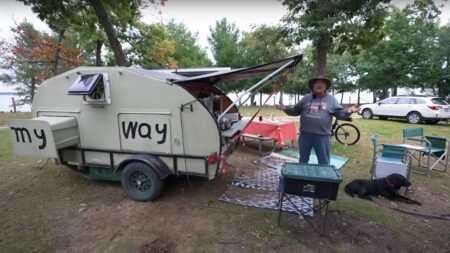Enjoying a fire pit on a cool evening surrounded by good company and good conversation is among the favorite activities for many of us. Whether you like s’mores and hot dog parties out in the yard, it all centers around a well-lit fire pit. But the fun and warmth fade in the smoke when you do not know how to maintain this outdoor feature. A fire pit is as good as you keep it. While many people who happen to have this staple in their outdoor space know how to keep it in prime condition, many beginners struggle with wood-burning fire pit maintenance. Luckily it is not too tricky once you know what to do and how.
Cleaning the fire pit is crucial as leaving it dirty can cause formation of harmful gases and unpleasant odors that can compromise the function of the fire feature, its enjoyment, and your health. Routine cleaning of a wood-burning fire pit after each use ensures that it remains functioning well.
This is the ultimate maintenance guide for wood fire pit. It also includes advantages and disadvantages, dos and don’ts of wood-burning fire pits; and different cleaning tips for various fire pit material types. Read on to know more.
Also Read: DIY Millennium Falcon Fire Pit is Perfect for the Galaxy Far, Far Away
How to Clean and Maintain a Metal Fire Pit
Metal fire pits have been a popular choice for generations. However, without proper cleaning and maintenance, these hardy metals can be susceptible to corrosion and ultimately, demise. Steel and copper can handle flames, burning wood and are extremely durable. If you have a metal fire pit, you ought to know how to make it long-lasting with just a bit of love. Here are some tips to clean these metal fire pits.
- Once the metal fire pit cools down, collect the ashes with a small shovel and store them in a bucket to be used in your garden
- Now bathe the container in hot soapy water. You can use a mild soap for best results
- Scrub the insides of the vessel using a soft fabric. Then rinse thoroughly and pat dry with a towel
- Ensure it is completely dry and covered at all times when not in use to prevent corrosion
This way you can maintain your metal fire pit and ensure its longevity.
How to Clean and Maintain Cast Iron Fire Pit
Cast iron is a durable choice for fire pits and is somewhat cheaper than its steel counterparts. While it does require a bit of tending to, it is hardy and long-lasting making it an ideal option. It has far greater heat retention than steel or copper and keeps you warm for longer after the fire has died out. It does demand a bit of care and maintenance to be in prime condition. Here is how to clean and maintain your cast iron fire pit.
- Wait for the fire pit to cool off completely and then empty it
- Scrub down the surface of the cast iron fire pit with steel wool and a bucket of warm water
- Rinse and dry with a soft cloth
- Make sure to keep it rust-free for enhanced durability
The best part about the cast iron fire pit is that no matter how far gone it seems, you can always restore it with a few tricks.
Also Read: Recycled Granite Fire Pits for Eco-Conscious Homeowners
How to Clean and Maintain a Stone Fire Pit
Stone fire pits are usually installed as a more permanent outdoor feature and tend to be slightly bigger than their counterparts. The cleaning process for this one is also different than the metal and cast iron fire pits. Since it is made of stone, there is no worry about corrosion or wear and tear and you can leave it out in the open, whereas you have to keep metal and cast iron protected from water. Here is how you can clean a stone fire pit.
- The first step is to clear out all of the ash
- Then scrub the insides of the fire pit with a stiff brush to remove stuck debris
- Mix a few drops of dish soap with warm water to clean the fire pit
- Rinse it and dry it well. You may want to consider applying stone sealant to prevent soot from sticking and also to make the cleaning process easier
Even though you need to clean a stone fire pit like other fire pits regularly, it requires less maintenance than the rest.
Pros and Cons of Wood-Burning Fire Pit
Like everything else in the world, there are advantages and disadvantages of having a wood-burning fire pit in your outdoor living space. Wood-burning fire pits have been around for generations, with the first dating back to the middle Paleolithic period, around 200,000-400,000 years ago.
Also Read: 30 Outdoor Fire Pit Designs to Get Ready for Fall
Pros of Wood-Burning Fire Pits
Wood-burning fire pits have a rustic and cozy ambiance, which makes them a favorite traditional choice.
- It gives an authentic campfire experience with a cracking sound and the smoky aroma of burning wood.
- These fire pits are often more budget-friendly with easily accessible fuel sources as compared to their gas counterparts.
- When compared to gas or propane fire pits, wood-burning fire pits are relatively easier to install.
- Aside from the experience, it adds a certain aesthetic value to your space that other fire pits just cannot match.
Cons of Wood-Burning Fire Pits
While there are benefits of these fire pits, the disadvantages are also in abundance.
- A wood-burning fire pit requires high maintenance as you need to store and season firewood, clean it after every use, and tend to the fire.
- The smoke and ashes can be troublesome to many users, especially people with respiratory issues.
- Starting a fire in a wood-burning fire pit is more difficult than other fuel sources and can be time-consuming to maintain.
- It also requires a large storage area as compared to other fuels for fire pits.
Also Read: Fire Pit Reminiscent to ‘One Ring’ From Lord of the Rings
Dos and Don’ts of Wood-Burning Fire Pits
When you are using a wood-burning fire pit, there are some essential dos and don’ts that you should know to practice safe usage of this fire feature.
Dos of Wood-Burning Fire Pit
When employing a wood-burning fire pit on your property, there are some things that you should do.
- You should pick a safe spot and style for your fire pit. It should be placed on a non-combustible surface, away from flammable materials, buildings, trees or bushes, and overhanging branches.
- Keep the area surrounding your fire pit clear of any debris or dry leaves.
- As a safety feature, install a fire extinguisher, garden hose, or bucket of water near the fire pit for fire emergencies.
- Pick dry and seasoned firewood to lessen excessive smoke and sparks.
- You should always monitor the fire at all times and keep kids and pets from getting too close to the fire.
- Use a screen or spark guard to capture any runaway sparks from flying out of the fire pit.
- Extinguish the fire completely before leaving the fire feature unattended or going inside for the day. You can use a snuffer lid to suffocate the fire or douse it with water.
Don’ts of Wood-Burning Fire Pit
There are some things that you do and there are some that you don’t when it comes to wood-burning fire pit. Let’s learn about the don’ts.
- Never place a wood-burning fire pit on a wooden deck or any flammable surface.
- You should not leave the fire unattended, especially with kids and pets around.
- Don’t use flammable liquids, such as gasoline or lighter fluid, to start or revive a fire; instead, use a long poker tool to do so.
- You should not overload the fire pit with too much wood or burn garbage, treated wood, or plastic that produces toxic fumes.
- Don’t place your fire pit too close to structures, overhanging branches, or shrubs.
- Never dispose of ashes immediately after dousing the fire, instead wait for them to cool down entirely.
Also Read: How to Turn a Washing Machine Drum Into a Fire Pit
Maintenance Tips for a Wood-Burning Fire Pit
To keep your wood-burning fire pit in prime condition, you must abide by some maintenance tips. Follow this to-do list and your fire pit will be an invaluable addition to your house for generations.
- Always use dry wood and avoid using moist logs. This will offer a clean burn, resulting in less build-up of soot.
- You should avoid adding plastic to the mix. It not only releases toxic fumes in the air, but melts onto the surface of the fire feature, making it harder to clean.
- Perform a deep clean every six months to keep your fire pit in healthy condition.
- During the wet and cold months, you should consider moving the portable fire pits to a dry place such as a garden shed or garage.
- Avoid putting out the fire by pouring water on it as the sudden change in temperature can cause structural damage.
- Practice daily cleansing of soot and ash after each burn to deter moisture build-up and protect metal and cast iron fire pits from corrosion.
- Always leave a thin crust of ash at the bottom of your fire pit as it can help it last longer.
Wood-burning fire pits are an amazing outdoor feature; they add aesthetic, warmth, and value to your overall property. If you have one at your home, consider this article as your guiding light on how to maintain your wood-burning fire pit and what are the advantages and disadvantages of it.
Follow Homecrux on Google News!




